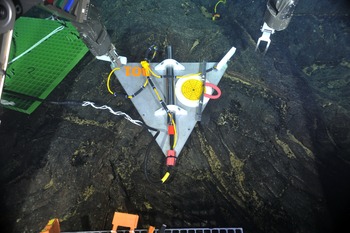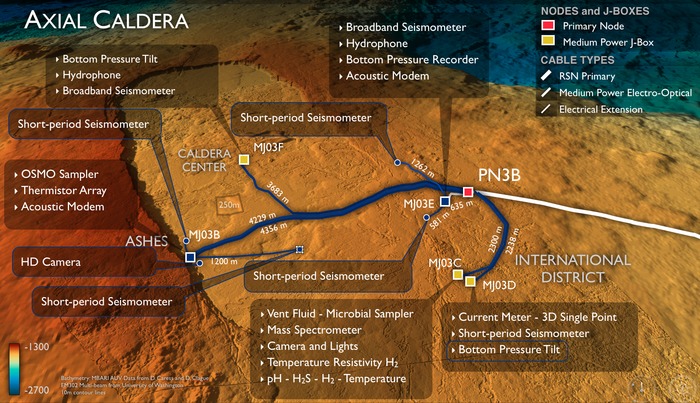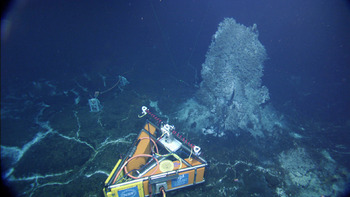
This short-period seismometer was deployed on a flat sheet flow ~ 1.3 km east of the ASHES hydrothermal field in 2013. The black ball in the yellow circle shows that it is perfectly level, helping to insure that the highest quality data comes off of this network. Axial Volcano is likely to be quite seismically active and we are anxious to get the real-time data on shore next year. This will help us understand magma and fluid migration in the subsurface of the volcano...and eventually these data may help us predict an eruption. VISIONS '13, Leg 4. Several earhquakes were detected in real-time during testing of these seismometers in 2013. Photo credit: NSF-OOI/UW/CSSF.
Location: 46.1ºN 130.0ºW Water Depth: 1510-1530 meters
The Axial Seamount Caldera study site at Primary Node PN3B is located within an active underwater volcano on the Juan de Fuca Ridge spreading center some 300 miles off Astoria, Oregon. Axial erupted in 1998 and most recently in April 2011. It hosts numerous active hydrothermal fields and abundant sites of diffuse flows of fluids into the overlying ocean.
Over 60% of global volcanism occurs in the oceans with most activity located along mid-ocean ridge spreading centers such as the Juan de Fuca Ridge. Some of the most exciting marine science discoveries in past decades have come from studying the relationships between submarine volcanoes, the gases and fluids they release, and the life that thrives in these novel environments. Many key questions, however, remain to be fully answered, such as: 1) How do submarine volcanoes support life in the absence of sunlight, and 2) What are the effects contributed by submarine volcanic activity and earthquakes on many geological, chemical, and biological processes in the oceans?
During the VISIONS'13 expedition, all of the long extension cables requiring the remotely operated cable laying system (ROCLS) were installed at this site. In total ~ 20 km of cables were installed, fully tested and they are all functional and await future activation. In addition, two medium powered junction boxes were installed at the ASHES vent field (MJ03B) and at the Eastern Caldera Site (MJ03E), respectively. Three subnets were installed and include:
ASHES
- 1) MJ03B hosting two short-period seismometers and a 3D thermistor array;
- 2) an HD camera at the base of the actively venting chimney called Mushroom
Eastern Caldera
- 3) MJ03E hosting two short-period seismometers
All subnets are fully tested and functional and await activation.
In 2014, the installation at Axial Seamount will be completed and all systems powered up. The 2014 installation will include:
- Medium Powered Junction Boxes (MJ03C, MJ03D, MJ03F)
- Short-Period Seismometers
- Bottom Pressure Tilt Meters
- Broadband Seismometer
- Low-Frequency Hydrophone
- Acoustic Modem
- Osmotic Sampler
- Thermistor Array
- Digital Still Camera and Lights
- Vent Fluid-Microbial Sampler (RAS PPS)
- Mass Spectrometer
- Temperature Resistivity H2 Probe
- pH-H2S-H2 and Temperature Sensors



